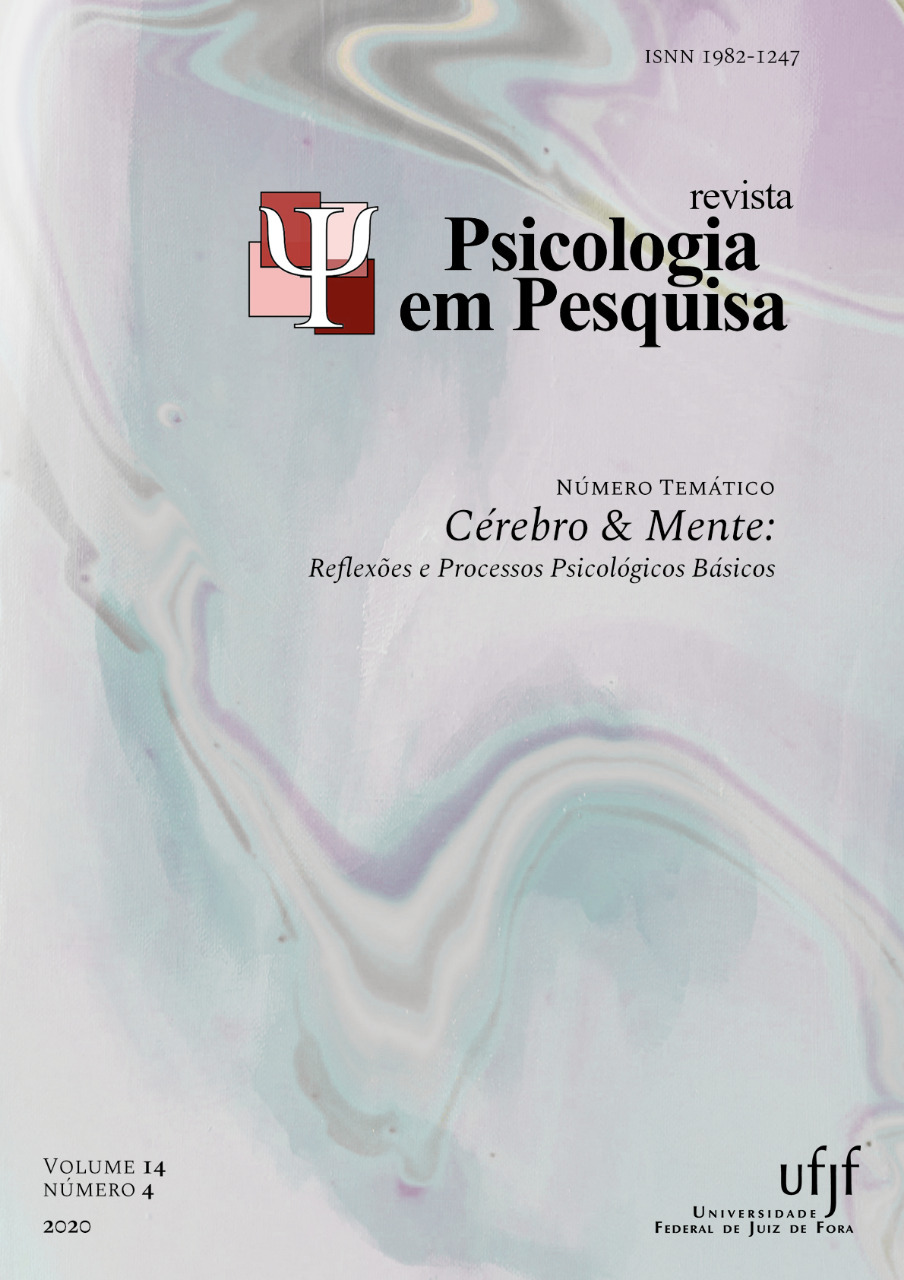A importância do contorno para o reconhecimento e discriminação visual de objetos
DOI:
https://doi.org/10.34019/1982-1247.2020.v14.32263Abstract
Em contraste com muitos sistemas artificiais de visão, nós, observadores humanos, podemos reconhecer prontamente objetos sólidos e discriminar visualmente suas formas 3-D, mesmo sob mudanças no ponto de vista e variações na orientação e iluminação do objeto. Embora a importância da disparidade binocular seja conhecida desde a década de 1830, a relevância e a riqueza perceptiva das informações fornecidas pelos contornos visuais para o reconhecimento e discriminação de objetos não são devidamente apreciadas. Este artigo revisará as contribuições científicas que demonstram que os contornos visuais e suas deformações ao longo do tempo (em resposta ao movimento do objeto ou do observador) proporcionam tanto ou mais informações sobre a forma do objeto do que outras formas de informação visual.
Downloads
References
De Winter, J., & Wagemans, J. (2008). The awakening of Attneave's sleeping cat: Identification of everyday objects on the basis of straight-line versions of outlines. Perception, 37, 245-270. doi: 10.1068/p5429
Hilbert, D., & Cohn-Vossen, S. (1983). Geometry and the imagination. New York: Chelsea.
Kennedy, J. M. (1974). A psychology of picture perception: Images and information. San Francisco, CA: Jossey-Bass.
Koenderink, J. J. (1984a). The internal representation of solid shape and visual exploration. In L. Spillmann & B. R. Wooten (Eds.), Sensory Experience, Adaptation, and Perception: Festschrift for Ivo Kohler (pp. 123–142). Hillsdale, NJ: Erlbaum.
Koenderink, J. J. (1984b). What does the occluding contour tell us about solid shape? Perception, 13, 321-330. doi: 10.1068/p130321
Koenderink, J. J. (1990). Solid Shape. Cambridge, MA: MIT Press.
Koenderink, J. J., & van Doorn, A. J. (1992). Surface shape and curvature scales. Image and Vision Computing, 10, 557-564. doi: 10.1016/0262-8856(92)90076-F
Liang, C., & Wong, K. K. (2010). 3D reconstruction using silhouettes from unordered viewpoints. Image and Vision Computing, 28(4), 579-589. doi: 10.1016/j.imavis.2009.09.012
Mendonça, P. R. S., Wong, K. K. and Cipolla, R. (2001). Epipolar geometry from profiles under circular motion. IEEE Transactions on Pattern Analysis and Machine Intelligence, 23(6), 604-616. doi: 10.1109/34.927461
Norman, J. F., Bartholomew, A. N., & Burton, C. L. (2008). Aging preserves the ability to perceive 3-D object shape from static but not deforming boundary contours. Acta Psychologica, 129, 198-207. doi:10.1016/j.actpsy.2008.06.002
Norman, J. F., Dawson, T. E., & Raines, S. R. (2000). The perception and recognition of natural object shape from deforming and static shadows. Perception, 29, 135-148. doi:10.1068/p2994
Norman, J. F., Dukes, J. M., Shapiro, H. K., Sanders, K. N., & Elder, S. N. (2020). Temporal integration in the perception and discrimination of solid shape. Attention, Perception, & Psychophysics. doi: 10.3758/s13414-020-02031-0
Norman, J. F., Lee, Y., Phillips, F., Norman, H. F., Jennings, L. R., & McBride, T. R. (2009). The perception of 3-D shape from shadows cast onto curved surfaces. Acta Psychologica, 131, 1-11. doi:10.1016/j.actpsy.2009.01.007
Norman, J. F., Phillips, F., & Ross, H. E. (2001). Information concentration along the boundary contours of naturally shaped solid objects. Perception, 30, 1285-1294. doi:10.1068/p3272
Norman, J. F., Phillips, F., Cheeseman, J. R., Thomason, K. E., Ronning, C., Behari, K., … Lamirande, D. (2016). Perceiving object shape from specular highlight deformation, boundary contour deformation, and active haptic manipulation. PLOS ONE, 11(2): e0149058. doi: 10.1371/journal.pone.0149058
Norman, J. F., & Raines, S. R. (2002). The perception and discrimination of local 3-D surface structure from deforming and disparate boundary contours. Perception & Psychophysics, 64, 1145-1159. doi: 10.3758/BF03194763
Norman, J. F., Todd, J. T., & Orban, G. A. (2004). Perception of three-dimensional shape from specular highlights, deformations of shading, and other types of visual information. Psychological Science, 15, 565-570. doi: 10.1111/j.0956-7976.2004.00720.x
Norman, J. F., Wheeler, S. P., Pedersen, L. E., Shain, L. M., Kinnard, J. D., & Lenoir, J. (2019). The recognition of solid object shape: The importance of inhomogeneity, i-Perception, 10(4), 1–14. doi: 10.1177/2041669519870553
Pollick, F. E., Giblin, P. J., Rycroft, J., and Wilson, L. L. (1992). Human recovery of shape from profiles. Behaviormetrika, 19, 65-79. doi: 10.2333/bhmk.19.65
Snodgrass, J. G., & Vanderwart, M. (1980). A standardized set of 260 pictures: Norms for name agreement, image agreement, familiarity, and visual complexity. Journal of Experimental Psychology: Human Learning and Memory, 6, 174-215. doi: 10.1037/0278-7393.6.2.174
Tse, P. U. (2002). A contour propagation approach to surface filling-in and volume formation. Psychological Review, 109, 91-115. doi: 10.1037/0033-295X.109.1.91
Van Effelterre, T. (1994). Aspect graphs for visual recognition of three-dimensional objects. Perception, 23, 563-582. doi: 10.1068/p230563
Wallach, H., & O'Connell, D. N. (1953). The kinetic depth effect. Journal of Experimental Psychology, 45, 205-217. doi: 10.1037/h0056880
Wagemans, J., De Winter, J., Op de Beeck, H., Ploeger, A., Beckers, T., Vanroose, P (2008). Identification of everyday objects on the basis of silhouette and outline versions. Perception, 37, 207-244. doi: 10.1068/p5825
Wheatstone, C. (1838). Contributions to the physiology of vision -- Part the first. On some remarkable, and hitherto unobserved, phenomena of binocular vision. Philosophical Transactions of the Royal Society of London, 128, 371-394. doi: 10.1098/rstl.1838.0019
Wong, K. K., and Cipolla, R. (2001). Structure and motion from silhouettes. Proceedings of the 8th IEEE International Conference on Computer Vision, 2, 217-222. doi: 10.1109/ICCV.2001.937627















